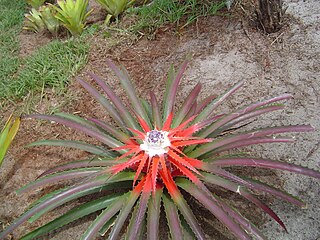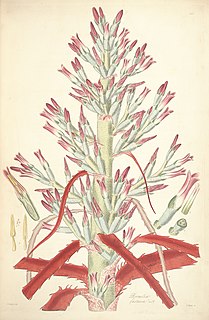
Bromelia serra is a species of plant in the family Bromeliaceae native to South America. It is one of several plants used by the Wichí people as a fiber for weaving called chaguar.

Bromelia is the type genus of the plant family Bromeliaceae, subfamily Bromelioideae. Bromelia species are widespread across much of Latin America and the West Indies, and are characterized by flowers with a deeply cleft calyx. The genus is named after the Swedish medical doctor and botanist Olof Bromelius (1639-1705).

The chupalla is a traditional Chilean horseman's hat made of straw. Many people in rural areas of Central Chile use it as well. In addition, it is often used when dancing the cueca and during Chilean rodeos.

Bromelia humilis is a plant species in the genus Bromelia. This species is native to Venezuela, Trinidad & Tobago, and the Netherlands Antilles.
Bromelia hemisphaerica is a plant species in the genus Bromelia. This species is native to Mexico and Costa Rica.
Bromelia palmeri is a plant species in the genus Bromelia. This species is endemic to southwestern Mexico, from Colima south to Oaxaca.
Alcantarea burle-marxii is a species in the genus Alcantarea. This species is endemic to Brazil.
Bromelia binotii is a plant species in the genus Bromelia. This species is endemic to Brazil.

Bromelia antiacantha is a plant species in the genus Bromelia. This species is native to Brazil and Uruguay.

Bromelia balansae is a plant species in the genus Bromelia. This species is native to Argentina, Brazil, Colombia, Bolivia, and Paraguay where it grows at elevations of 150 to 3,000 feet.

Bromelia karatas is a plant species in the genus Bromelia. This species is native to West Indies and to Latin America from San Luis Potosí + Sinaloa south to Brazil.
Bromelia lagopus is a plant species in the genus Bromelia. This species is native to Brazil.

Bromelia pinguin is a plant species in the genus Bromelia. This species is native to Central America, Mexico, the West Indies and northern South America. It is also reportedly naturalized in Florida. It is very common in Jamaica, where it is planted as a fence around pasture lands, on account of its prickly leaves. The fruit, known as piñuela, is dug out, protective "hair" removed, peeled like a banana, and eaten. They are slightly tart with a crunch from the seeds. The plant can be stripped of its pulp, soaked in water, and beaten with a wooden mallet, and it yields a fiber whence thread is made. In countries like El Salvador, it is used to make gruel.
Bromelia scarlatina is a plant species in the genus Bromelia. This species is native to Ecuador.
Bromelia chrysantha is a plant species in the genus Bromelia. This species is native to Venezuela, Colombia, and Trinidad & Tobago.
Bromelia goeldiana is a plant species in the genus Bromelia. This species is native to Venezuela and Brazil.
Bromelia tubulosa is a plant species in the genus Bromelia. This species is native to Venezuela.

Bromelia laciniosa, natively known as macambira, is plant in the bromeliad family, or in other words, the pineapple family—though not all bromeliads resemble the common pineapple. As a family, the histories of bromeliads have been well recorded, but the details of its many species, like Bromelia laciniosa, are not known. Bromelia laciniosa is native to Brazil and Argentina but cultivated in many other places.
Vriesea schultesiana is a plant species of the genus Vriesea. This species is endemic to Colombia. It is rare, listed as "near threatened."

Bromelia sylvicola is a species of Bromelia from Brazil.








